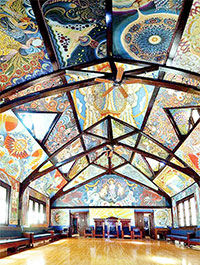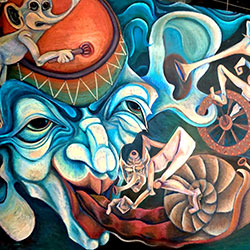
Inside the “Museum of Modern Renaissance.”
By Rachel Berets
“We think that the main purpose of art is to make the human soul soar,” said Nicholas Shaplyko, one of the founders of the “Museum of Modern Renaissance” in Somerville.
The museum, which Shaplyko owns with his wife Ekaterina Sorokina, is not a museum in the traditional sense – it’s Shaplyko and Sorokina’s private residence, filled with art that the two have created together.
Their art covers the walls, ceilings, and surfaces with bold colors and mythological icons, all in an effort to create a beautiful space for themselves and others. “It’s not a money machine,” said Shaplyko. “It’s our life. We are doing our artwork because we can’t not do it.”
Shaplyko and Sorokina bought the building, a former masonic lodge, in 2002 and turned it into their private residence, a museum, and a performance space. They change the art pieces as they see fit, replacing larger works with smaller ones or vice versa. “It’s a process, it’s feeling out the space,” said Shaplyko.

A newer work currently on display at the “museum.” ~ Photos courtesy of “Museum of Modern Renaissance”
This summer, Shaplyko and Sorokina have been busy creating new works together. They often post updates about their work on the museum’s Facebook page, featuring pictures of Shaplyko leaning over a canvas on a hardwood floor.
For these new works, the process is the same as always – unplanned and enigmatic. “Whatever comes to our minds goes straight to the paper or the canvas, we are not thinking about what we are doing, it’s just kind of natural.”
They call their style “Mystical Realism” or “Magical Realism,” but Shaplyko admits that these terms were originally a tongue-in-cheek response to the frequently-asked question “What style do you work in?” that somehow stuck.
“Basically all art and all reality is inside your brain. Every human activity is created by someone’s brain, like Einstein or Steve Jobs. It’s all creativity of the mind.” said Shaplyko.
The museum does not have normal hours, instead the couple leads private tours, booked by appointment, through their residence. The small groups, which range from two to fifteen, give them an opportunity to talk to people about their work and artistic process. Shaplyko sees this as a positive, differentiating them from bigger, name brand museums.
“When you go to big museums you basically know what you are going to see there, because all of the well-known artworks you’ve seen before on the computer or in books or as reproductions,” said Shaplyko. “But when artists can explain to you what their work means and talk to you personally, it’s different. You can’t talk to Michaelangelo.”
When guests visit the experience they have at the museum is up to them. “We don’t want to force you to feel anything if you don’t feel anything. It’s totally up to you. We just give you an opportunity. We don’t dictate and we don’t force you to feel anything,” said Shaplyko.
When I asked Shaplyko if he could tell which visitors connect with the artwork he responded, “I am not an x-ray machine. Some people are emotional and their emotions are visible, some people are kind of closed and you can’t see anything but it doesn’t mean that they aren’t receptive or that nothing is cooking inside.”
















Reader Comments